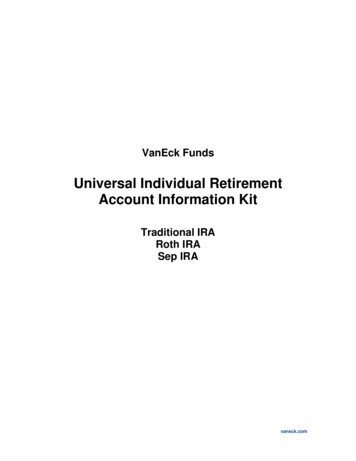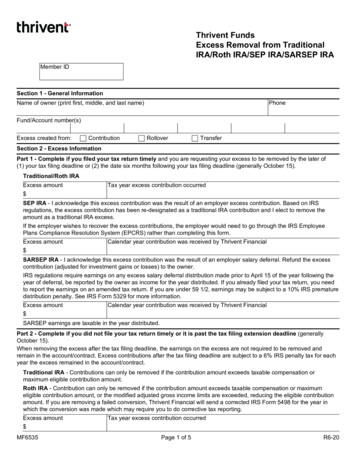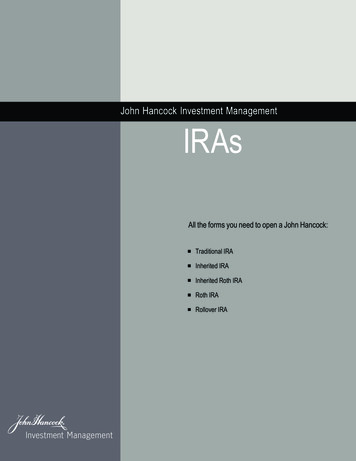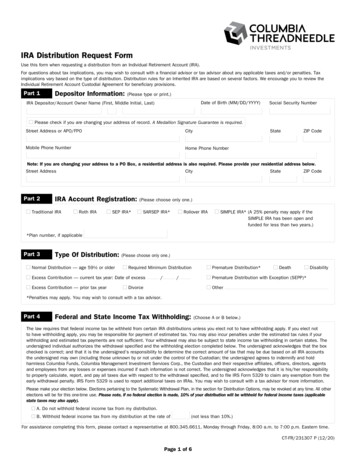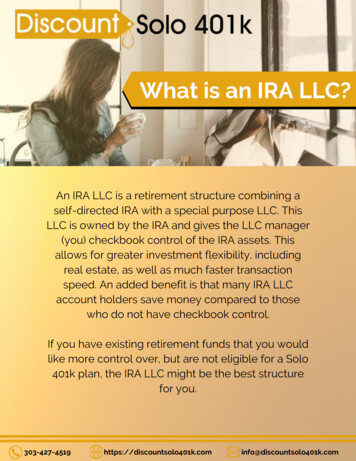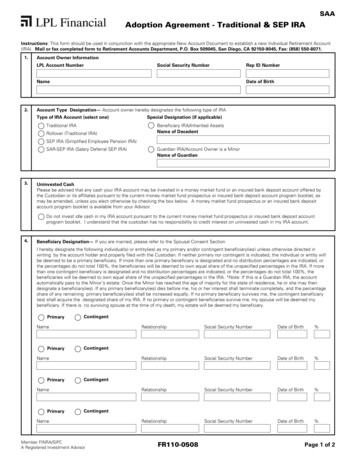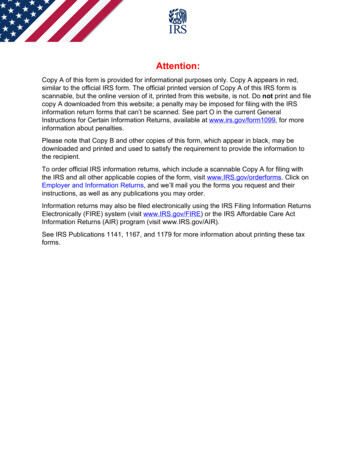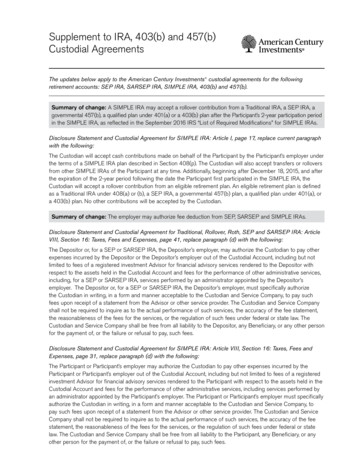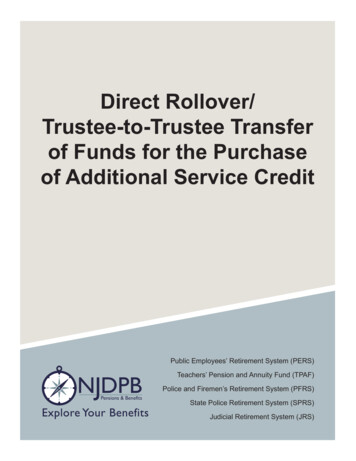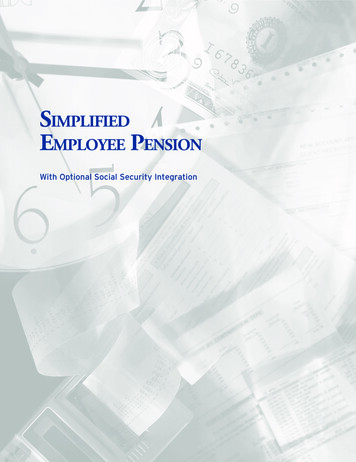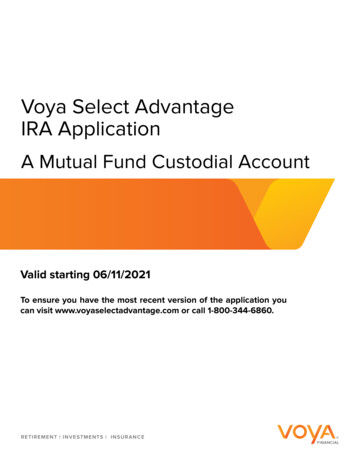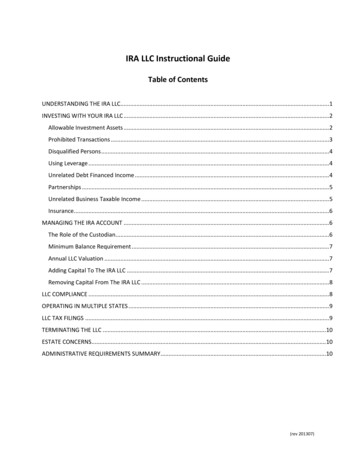
Transcription
IRA LLC Instructional GuideTable of ContentsUNDERSTANDING THE IRA LLC.1INVESTING WITH YOUR IRA LLC .2Allowable Investment Assets .2Prohibited Transactions .3Disqualified Persons .4Using Leverage .4Unrelated Debt Financed Income .4Partnerships .5Unrelated Business Taxable Income .5Insurance.6MANAGING THE IRA ACCOUNT .6The Role of the Custodian .6Minimum Balance Requirement .7Annual LLC Valuation .7Adding Capital To The IRA LLC .7Removing Capital From The IRA LLC .8LLC COMPLIANCE .8OPERATING IN MULTIPLE STATES .9LLC TAX FILINGS .9TERMINATING THE LLC .10ESTATE CONCERNS.10ADMINISTRATIVE REQUIREMENTS SUMMARY .10(rev 201307)
Safeguard Checkbook IRA LLC Instructional GuideCongratulations on the formation of your Checkbook IRA LLC. This self-directed retirement planis a powerful tool you can use to grow your retirement through the ability to actively direct theinvestments of your plan funds in a wide array of traditional and non-traditional assets.This Instructional Guide is meant to assist you with the key concepts of investing with the planand maintaining the plan through proper documentation and filings.You have also been provided with a Memorandum of Law related to the IRA LLC by our providerlaw firm Draneas & Huglin, PC. Some of the information in this Instructional Guide is arestatement of material in that document – in less technical language. You should be sure toread both documents fully.Please contact your Safeguard advisor directly if you have questions not covered by theseinstructions and related to operational and investment matters.Please be aware that Safeguard IRA & 401(k) Advisors cannot provide tax advisement. You areencouraged to work with your own tax advisor when it comes to matters of tax planning, stateor federal tax filings, formulating IRA contribution amounts, and distribution activities.UNDERSTANDING THE IRA LLCA Checkbook IRA LLC is a tool designed to provide the IRA account holder with maximumflexibility and control over investment decisions, while conforming with IRS requirementssurrounding the tax-sheltered status of the IRA.A checkbook IRA LLC consists of two layers: A self directed IRA account held by IRA Services Trust Co.A specially formed LLC that functions as an investment holding company for that IRAaccountAll IRA events such as contributions, distributions and transfers/rollovers must go through theIRA account at IRA Services Trust Co. This ensures proper compliance reporting.All investment transactions take place within the LLC entity. Investments are titled in the nameof the LLC, and all expenses and income transactions associated with the acquisition,maintenance or sale of an asset are handled through the LLC bank account.A flow chart on the following page illustrates how the self directed IRA and the LLC fit together.Page 1
Safeguard Checkbook IRA LLC Instructional GuidePrior IRA/401kAccountNon-taxableTransfer/RolloverSelf Directed IRA(IRA Services Trust Co.)IRA Services holds and reports on the IRA account. The sole investment of this IRA is theLLC entity. IRA contributions, rollovers and distributions must be processed through IRAServices. You will provide IRA Services with the end-of-year value of the LLC.IRA purchases LLC ownership & capital is sent to LLCbankIRA LLC(Bank Account)The LLC is an investment holding company, owned by the IRA and managed by you. Youselect a bank/brokerage to hold a business account in the name of the LLC.AYou have signing authority to execute and administer investment transactions.LLC purchases investmentassetsInvestmentAssetsAll investment transactions are executed in the name of the LLC with expenses andincome being handled through the LLC account.IRA Services is not involved in investment transactions.INVESTING WITH YOUR IRA LLCOnce you have an established and funded LLC bank or brokerage account, you are ready tostart investing.A Few Quick Tips:When making offers, signing contracts or taking title to assets, you will do so on behalf of theLLC, in your role as Manager, for example:Best Investment Holdings, LLC, John Q. Public, managerAll plan investment related expenses need to be paid with plan fundsAll income received from investments needs to be deposited back into the plan accountDo not transact in any way between the plan and yourself or disqualified partiesAllowable Investment AssetsThe LLC may be invested in a diverse range of asset classes, from traditional publicly tradedequities, bonds and funds to non-traditional assets such as title to real property, promissorynotes and stock of closely held corporations.Page 2
Safeguard Checkbook IRA LLC Instructional GuideThe only assets specifically disallowed are life insurance policies and what are referred to ascollectibles, including for example: Artwork,Rugs,Antiques,Metals - there are exceptions for certain kinds of bullion,Gems,Stamps,Coins - there are exceptions for certain coins of specified purity,Alcoholic beverages, andCertain other tangible personal property.There are exceptions to the collectibles exclusion that allow for certain types of coins to be heldby the plan.Note that the IRA LLC may not be a shareholder of a subchapter S Corporation. Such ownershipby a non-person is not allowed under the subchapter S rules, and would cause the corporationto be re-characterized as a subchapter C corporation.Prohibited TransactionsRules defining the prohibited use of IRA and 401(k) plan funds are defined in IRC 4975(c)(1) andIRS Publications 590 & 560.Greatly simplified, the key principal is as follows:All plan activities must be for the exclusive benefit of the plan, and there may be no direct orindirect benefit to the account holder or a disqualified party to the plan.This section of the code identifies prohibited transactions to include any direct or indirect: Selling, exchanging, or leasing, any property between a plan and a disqualified person.For example, your IRA LLC cannot buy property you currently own from you.Lending money or other extension of credit between a plan and a disqualified person.For example, you cannot personally guarantee a loan for a real estate purchase by yourIRA LLC.Furnishing goods, services, or facilities between a plan and a disqualified person.For example, you cannot use personal furniture to furnish your IRA LLC owned rentalproperty. Sweat equity performing repairs or improvements is not allowed.Transferring or using by or for the benefit of, a disqualified person the income or assetsof a plan.For example, your IRA LLC cannot buy a vacation property you or your family intends touse, and no, you cannot use it and pay fair market rent.Page 3
Safeguard Checkbook IRA LLC Instructional Guide Dealing with income or assets of a plan by a disqualified person who is a fiduciary actingin his own interest or for his own account.For example, you should not loan money to your CPA.Receiving any consideration for his or her personal account by a disqualified person whois a fiduciary from any party dealing with the plan in connection with a transactioninvolving the income or assets of the plan.For example, you cannot pay yourself income from profits generated from your IRA LLCowned rental property.Disqualified PersonsA disqualified person (IRC 4975(e) (2)) is defined as: The IRA ownerThe IRA owner’s spouseAncestors (parents, grandparents)Lineal Descendents (children, grandchildren)Spouses of Lineal Descendents (son-in-law, daughter-in-law)Investment advisorsFiduciaries – those providing services to the planAny business entity i.e., LLC, Corp, Trust or Partnership in which any of the disqualifiedpersons mentioned above has a 50% or greater interest.Using LeverageYou may leverage the investments of your IRA LLC with debt instruments such as a mortgage ormargin trading account. Any such debt must be non-recourse in nature, meaning there can beno personal guarantee pledged by the account holder or a disqualified party to the accountholder. The lender’s only security must be the asset related to the debt.When gains from an investment are obtained through the use of leverage, a tax is applied tothe Unrelated Debt Financed Income that results.Unrelated Debt Financed IncomeWhen a tax-deferred or tax-exempt entity such as a non-profit or IRA receives income fromproperty that has been financed, a tax is applied on the resulting Unrelated Debt-FinancedIncome (UDFI).The general principal is that the tax exempt entity’s investment is fully sheltered from taxation,but the portion of the income generated through the use of borrowed, non-exempt funds istaxable.Page 4
Safeguard Checkbook IRA LLC Instructional GuideTopics surrounding UDFI are outlined in IRC 514, which defines debt-financed property as “anyproperty which is held to produce income and with respect to which there is acquisitionindebtedness at any time during the taxable year.”The tax is applied to any profit generated through the use of acquisition indebtedness, such asrental income from real estate or gains on the sale of financed property. UDFI no longer appliesonce the debt has been paid off for a total of 12 months.Investors using a self directed IRA would typically encounter this type of taxation wheninvesting in real estate that has been financed with a non-recourse mortgage. The tax wouldalso apply if the IRA owns an interest in a partnership or LLC that obtained financing.IRS Publication 598 discusses UDFI taxation.The tax is reported by the IRA using form 990-T, and is a trust tax separate from your personaltax return.Filing the 990-T return will be your responsibility and we strongly recommend you consult withyour tax advisor before entering into a transaction that will incur UDFI.If you are unsure about a transaction, contact your Safeguard advisor before taking actionPartnershipsThe IRA LLC may partner with non-disqualified parties into investments. Examples include:Taking title to real property as tenants-in-commonJoint venturesBeing a member of a Limited Liability Company (LLC) or Limited Liability Partnership (LLP).The IRA LLC may also hold an interest in a partnership where disqualified parties hold interest,so long as the combined interest of the plan and disqualified parties does not represent acontrolling interest in the entity. Controlling interest can be defined both in terms of equityparticipation and/or decision-making control. Extreme caution is advised in such cases, and westrongly recommend you consult a tax advisor prior to entering into such arrangements.Unrelated Business Taxable IncomeIf the IRA LLC invests into an activity that represents a trade or business, the income generatedfrom that investment may be subject to Unrelated Business Taxable Income (UBTI). The IRSdefines a trade or business as any activity regularly carried on for the production of incomefrom selling goods or performing services. Activities are considered regularly carried on if theyshow frequency and continuity similar to comparable commercial activities of a non-exemptbusiness.Examples might include: An equity position in a LLC operating a restaurant, retail or other type service businessPage 5
Safeguard Checkbook IRA LLC Instructional Guide Repeatedly purchasing real estate with the intention of improving and/or quicklyreselling that property (flipping)Leasing plan assets other than real propertyBuying and selling personal propertyGenerally speaking, dividends, holding real property for rental, and lending money areconsidered passive and would not be subject to UBTI.IRS Publication 598 discusses UBTI taxation.The tax is reported by the IRA using form 990-T, and is a trust tax separate from your personaltax return.Filing the 990-T return will be your responsibility and we strongly recommend you consult withyour tax advisor before entering into a transaction that will incur UBTI.If you are unsure about a transaction, contact your Safeguard advisor before taking actionInsuranceIf the plan is investing in real property you will want to obtain appropriate insurance for hazardsand potentially landlord or liability coverage.Keep in mind, the insured entity is the LLC. As a result, you should work with your insuranceprofessional to obtain a policy that provides proper coverage for the LLC. This should be acommercial policy separate and distinct from any personal policy you may hold with an insurer.MANAGING THE IRA ACCOUNTYour self-directed IRA is held by IRA Services Trust Co, who serves as custodian andadministrator for the account.Website:www.ira123.comCustomer Service:800-248-8447Business Hours:Monday – Friday, 8:00 am – 5:00 pm Pacific time.The Role of the CustodianAs custodian, IRA Services Trust Co. is responsible for holding and reporting on the IRA account.They are the conduit through which any IRA contributions, rollovers/transfers or distributionsmust be made and reported. These services are similar to those provided by any IRA accountcustodian, but with the ability to hold non-traditional assets such as the LLC in the account.The IRA essentially holds two assets: cash and ownership interest in the LLC.IRA Services has policies associated with operating your account that you should be familiarwith, as it will be your responsibility to manage the IRA and your relationship with IRA ServicesTrust Co.Page 6
Safeguard Checkbook IRA LLC Instructional GuideMinimum Balance RequirementA minimum 300 cash balance is required to be maintained. IRA Services Trust Co. drawsfuture fees on your account form this cash portion. IRA Services Trust Co. will notify you if thiscash balance is getting low and needs to be replenished. You may incur additional fees if thecash balance is not sufficient to cover costs on the account.This cash balance is IRA capital, so it must initially be funded via an IRA contribution,transfer/rollover from another plan, or a liquidation of capital from the IRA’s investment in theLLC. You are allowed to reimburse the IRA for fees incurred in the current or prior tax year.Annual LLC ValuationIn order to produce annual reporting to the IRS on form 5498, IRA Services Trust Co. will requirea statement of value for the LLC held by your IRA. They will remind you of this need inDecember and you can provide the valuation online or using a LLC Valuation form available onthe IRA Services Trust Co. website. If you are under age 70 ½, your signature on the valuation isall that is required. If you are over 70 ½ and therefore taking Required Minimum Distributionsfrom the IRA – or otherwise have a taxable event associated with the IRA – the signature of alicensed tax professional will be required as well.You may contact IRA Services Trust Co. for assistance in managing your account andunderstanding their operational policies. You may view your account online, and the formsnecessary to execute transactions on the account are available on the IRA Services website.Adding Capital To The IRA LLCIf you wish to add capital to the IRA LLC, this must come from the self directed IRA, as the IRA isthe sole member of the LLC. All IRA funds added t to the LLC must be routed through IRAServices Trust Co. in order to be properly reported.UNDER NO CIRCUMSTANCES should you place capital directly into the LLC that has not beenrouted through IRA Services Trust Co – whether from you personally or from another IRA orretirement plan. To do so breaks the proper chain of reporting and can have severe taxconsequences.You may add cash to the IRA account at IRA Services Trust Co. via an IRA contribution or atransfer/rollover from another qualified retirement plan in your name that is compatible withthe type of self directed IRA you have. IRA Services Trust Co. provides the necessary forms andassistance to facilitate these processes.The IRA capital is added to the LLC via an Investment Authorization form available through IRAServices Trust Co. This form instructs IRA Services Trust Co. to purchase additional membershipunits of the LLC on behalf of your IRA and send the capital to the LLC bank/brokerage account.The process of adding capital to the LLC can take from 5-20 business days, depending on thesource of funds and how responsive another IRA or 401(k) administrator is to a request fortransfer.Page 7
Safeguard Checkbook IRA LLC Instructional GuideSome steps in the process may be expedited at an additional cost.When member capital is added to the LLC, this should be recorded on the LLC record ofmember contributions/distributions.Removing Capital From The IRA LLCAt age 59 ½ or later, you are able to take distributions from your IRA without penalty.In the year during which you turn 70 ½, you will begin taking Required Minimum Distributions(RMD’s) from a tax-deferred IRA account. Such RMD’s are not required from a Roth IRA.You may also choose to move IRA capital from the self directed IRA LLC to another retirementplan in your name via a transfer or rollover.There are several tax and reporting considerations that accompany plan distributions, and westrongly encourage you to work with your CPA on planning for and taking distributions fromyour IRA.Taking a distribution is a two step process which must be processed and recorded by IRAServices Trust Co. as custodian for your IRA.UNDER NO CIRCUMSTANCES should you take capital directly out of the LLC without goingthrough IRA Services Trust Co – whether to you personally or to another IRA or retirement plan.To do so breaks the proper chain of reporting and can have severe tax consequences.The first step is to send capital from the LLC to the IRA account. This is a liquidation ofownership in the LLC and must be reported using a Deposit Information form that is availablefrom IRA Services Trust Co. Funds may be sent by check or wire.Once the cash is in the IRA account, you may request a distribution to you (which may betaxable), or a transfer to another IRA.The process of taking a distribution personally will typically take 5-15 business days, dependingon whether you use checks or wires to move the funds at each stage.Some steps in the process may be expedited at an additional cost.When member capital is distributed from the LLC, this should be recorded on the LLC record ofmember contributions/distributions.LLC COMPLIANCEA LLC is a state registered business entity. The rules and procedures for maintaining theregistration of the LLC and the ability to conduct business in a state vary from state-to-state. Itis your responsibility to understand and comply with state rules related to the maintenance andadministration of your IRA LLC.We strongly recommend that you work with a locally licensed tax and/or legal professional toassist you in complying with state & local laws associated with the operation of your LLC.Page 8
Safeguard Checkbook IRA LLC Instructional GuideMany states require an “annual report”, which is essentially a confirmation that the LLC is still inbusiness, verification of address, and potentially a registration fee. This annual report may bedue at a set time each year or the anniversary date of the initial LLC filing, depending on thestate. Failure to file an annual report may result in your LLC being administratively dissolved bythe state. The secretary of state business division is generally the authority for this process.Annual reminders are provided by many states, but not all. It is your responsibility to know andfulfill the annual report requirements for your LLC.Some states have a business franchise or privilege tax that applies to all businesses operating inthe state. This may be in place of or in addition to the LLC annual report. Failure to file this taxmay result in administrative dissolution of the LLC as well as penalties.Some states have a state income tax or capital stock tax that applies to businesses operating inthe state. Generally speaking your LLC will not be subject to such taxation, as it is a disregardedentity with tax liability flowing to a tax-exempt IRA account. You may be required to submit thestate return, however, even if you will not have tax owed.There may be business license requirements for your LLC at the state, county or municipal level.Keep in mind, the IRA LLC is a holding company that is a disregarded entity for tax purposes atthe federal level, and is wholly owned by a tax-exempt IRA. The IRA LLC is not an operatingbusiness. This structure may or may not be wholly recognized by a state or local jurisdiction inthe same way.OPERATING IN MULTIPLE STATESA LLC is licensed by a specific state, for the purpose of conducting business within that state. Ifyour investment activities will occur outside the state in which your LLC was formed, you mayneed to register the LLC as a foreign entity to do business in the additional state. Suchregistration is required to maintain compliance with local state law and to provide your LLCwith access to the courts of the state to defend against or pursue a legal action.Generally speaking, holding income producing property is considered doing business in a stateand would require such registration. Pure investment holdings such as shares of a businessformed within the second state and some forms of notes may not require such registration.You would not typically need to register the IRA LLC in a 2nd state before completing atransaction, but you would want to obtain such registration shortly thereafter.LLC TAX FILINGSThe IRA LLC has been established as a single-member LLC wholly owned by a tax-exempt IRA.For federal tax purposes, the LLC is viewed as a disregarded entity. As such, the tax andreporting liability for the LLC flow through to the sole owner – the IRA account. The annual5498 filing prepared by IRA Services Trust Co. on behalf of your IRA is generally all that isrequired. No federal tax return will be required for the LLC.Page 9
Safeguard Checkbook IRA LLC Instructional GuideGenerally, most states are tied in with the federal filing requirements. However, you shouldcontact a tax professional in your own state to determine the correct filing requirements foryour particular state.If the IRA has unrelated business income or debt financed income, the IRA will have additionalfilings associated with these activities. A Federal form 990-T will be required. The LLC statemay also have a tax return requirement in these scenarios.TERMINATING THE LLCThe LLC may be terminated by the process of distributing the assets to the member (the IRA)and filing for dissolution with the state.This process may be complex, depending on the nature of assets held within the LLC and thestate of LLC formation.You should consult with your tax and/or legal advisor prior to terminating the LLC.ESTATE CONCERNSAs part of the plan setup, you will have established beneficiaries for your IRA account. In theevent of your death, your account beneficiaries will inherit the IRA as well as the LLC that isowned by the IRA.As manager of the LLC, you should also plan for the administration and wind-down of the LLC inthe event of your death.If you are married, you may have appointed your spouse as a co-manager of the LLC. Thiswould give them the administrative control necessary to handle the LLC at your death.You may want to make arrangements for a successor manager as an alternative to, or inaddition to having a co-manager. A successor manager could be appointed at the time of yourdeath or incapacitation and takeover administration of the LLC. A blank resolution template isincluded in the Forms section of your documents, and could be used to designate a successormanager for the LLC.Keep in mind, there may be state specific rules regarding the appointment of a successormanager, notary requirements, and the designated person’s acceptance of the role. Westrongly advise you to consult with a state licensed attorney familiar with LLC corporate lawbefore appointing a successor manager.You should be sure that whoever will be handling your affairs is aware of the existence of theIRA LLC and knows where the plan documents are held.ADMINISTRATIVE REQUIREMENTS SUMMARYIn your role as manager of the LLC, it is your responsibility to document plan activities and fulfillcertain reporting obligations.Generally speaking, you will need to:Page 10
Safeguard Checkbook IRA LLC Instructional GuideKeep records of LLC investment activities such as bank statements, title to assets and receiptsfor expenses and income.Provide IRA Services Trust Co. with an annual statement of fair market value for the LLC.Comply with state specific rules related to the LLC Annual Report and potentially state tax orbusiness license requirements.Document changes in the LLC member contribution that may result from adding or removingcapital from the LLC such as IRA contributions/rollovers or IRA distributions.Manage tax records such as forms W-9 and 1099-Misc for any contractors providing services tothe plan as required by law.File form 990-T if the IRA LLC is subject to UDFI or UBTI taxationSeveral of the above items have been covered in greater detail elsewhere.Forms for managing and documenting plan activities are contained in the Forms section.If you require services such as those of a tax advisor, bookkeeper, or attorney to assist in theadministration of the IRA LLC, reasonable fees may be paid from plan funds for such services.Page 11
UNDERSTANDING THE IRA LLC A Checkbook IRA LLC is a tool designed to provide the IRA account holder with maximum flexibility and control over investment decisions, while conforming with IRS requirements surrounding the tax-sheltered status of the IRA. A checkbook IRA LLC consists of two layers: A self directed IRA account held by IRA .
